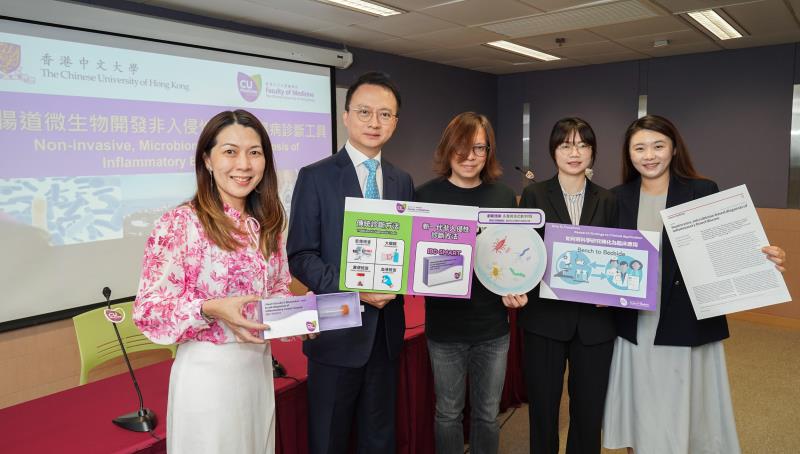Microbiome-based noninvasive diagnostic tool now available for IBD




 From left: Prof Siew Ng, Prof Francis Chan, Mr Eric Lam, Dr Jiaying Zheng, Prof Wendy Zhang
From left: Prof Siew Ng, Prof Francis Chan, Mr Eric Lam, Dr Jiaying Zheng, Prof Wendy ZhangResearchers at the Chinese University of Hong Kong (CUHK) have developed a microbiome-based noninvasive diagnostic tool for inflammatory bowel disease (IBD), which received a silver medal at the Geneva International Exhibition of Inventions 2024.
Lack of noninvasive diagnostic test for IBD
The incidence of IBD is rising rapidly in Asia, and the number of patients in China is expected to exceed 1.5 million by 2025. Symptoms of IBD and irritable bowel syndrome (IBS) overlap to some extent, which can make it difficult to distinguish between these disorders. [World J Gastroenterol 2022;28:4102-4119; J Clin Med 2020;10:31]
“Each year, >8 million individuals worldwide experience gastrointestinal symptoms and may require endoscopies,” said Professor Francis Chan, Co-director of Microbiota I-Center (MagIC), CUHK. “Diagnosing IBD often involves a long waiting time for investigations, including invasive endoscopic procedures. There is an urgent need for a noninvasive, accurate diagnostic test for IBD.”
Therefore, the researchers performed metagenomic sequencing of 5,979 faecal samples from individuals with or without IBD from 111 countries. Results showed that IBD patients had microbiota alterations, characterized by more toxin-producing bacterial genes in the gut, including adherent-invasive E. coli and Proteus mirabilis, along with a deficiency of various bacterial species with anti-inflammatory functions. [Nat Med 2024;doi:10.1038/s41591-024-03280-4]
Applicable to inactive UC and CD
“We selected 10 and nine bacterial species for construction of diagnostic models for ulcerative colitis [UC] and Crohn’s disease [CD], respectively,” said Dr Jiaying Zheng of the Department of Medicine & Therapeutics, CUHK. “These diagnostic models achieved areas under the curve [AUC] >0.90 [0.90 for UC; 0.94 for CD] for distinguishing IBD from controls in the discovery cohort.”
Notably, the diagnostic models can distinguish patients with inactive UC and CD from controls, with AUCs of 0.89 and 0.84, respectively. “These data suggest that bacterial biomarkers may not just be a consequence of inflammation, but may also contribute to—or possibly reflect—underlying disease pathogenesis,” commented the researchers.
“There is potential to alleviate inflammation through modulation of gut microbiota,” added Professor Wendy Zhang of the Department of Medicine & Therapeutics, CUHK,
Nearly 90 percent sensitivity and specificity
To translate clinical findings into real-world applications, the research team developed multiplex digital droplet polymerase chain reaction (ddPCR) technology to enable rapid and effective diagnosis of IBD. This ddPCR technology offers increased sensitivity and specificity, shortens turnaround time, and is cost-effective.
“Our models maintained satisfactory performance – sensitivity at 88 percent and specificity at 89 percent—in transethnic validation cohorts across eight populations, including Hong Kong, mainland China, Australia, Spain, the Netherlands, Denmark, the UK, and the US,” reported the researchers.
The innovation received national and international recognition, including a silver medal in the Geneva International Exhibition of Inventions 2024.
“We have developed a first-in-class, microbiome-based, next-generation diagnostic tool for chronic intestinal diseases,” said Professor Siew Ng, Co-director of MagIC, CUHK. “We are also conducting large-scale transethnic, multicentre studies to further explore the potential of these biomarkers in disease monitoring, drug response prediction, and patient stratification in IBD.”